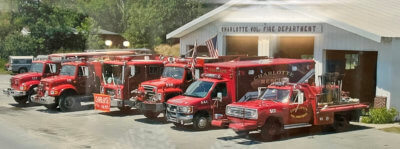A history of the Charlotte Fire and Rescue Service
With the very real possibility that the Charlotte Fire and Rescue Service may change from a private, nonprofit organization to a municipal organization, this seems an appropriate time to look back at the history of fire and rescue service in the town.
The fire and rescue service began as an organization of volunteers in 1950.
Before then, medical emergencies in Charlotte were taken to the hospital by a Burlington undertaker. In Burlington, this continued to be the primary way medical emergencies were transported into the 1960s, Chris Davis said.

Charlotte had to rely on firefighting to come from departments in Shelburne, Hinesburg and Burlington. There was no South Burlington nor Ferrisburgh fire departments in those days.
“A group of concerned citizens — some of them had experience from having served in various branches of the military or were just concerned local farmers and folks — chartered the original fire department,” said Davis, who over the years has been Charlotte Fire and Rescue’s chief and is now a member of the board of directors. “Within just a year or two, they had trained themselves up and started offering a very early version of an ambulance service.”
Many of the early volunteers were prominent farming families.
“Basically, it was a who’s who of early Charlotte families who were involved as the nucleus of that department,” Davis said.
The fledgling fire department bought its first pumper fire truck in the 1950s with money donated by Harry Webb. A member of the family that founded Shelburne Museum and Shelburne Farms, Webb owned two farms in Charlotte, said Dave Schermerhorn, who joined in 1964, when he was 18 years old.
When that first truck broke down, the department bought a second truck in the 1960s. Schermerhorn isn’t sure, but thinks that truck may have been purchased with funds from the town.
A couple of years after buying its first fire truck, the department bought a 1950s hearse and painted it orange. That became Charlotte’s first ambulance, said Davis, who joined rescue in 1982 and a year later joined the fire department.
The property where the fire and rescue building is located was donated by the Williams family on the condition it would be used for fire services.
“The members built the first station, which is basically located where the living quarters and office section of the building is today,” Davis said.
That building was a two-bay garage. In the original fire and rescue station, members would empty one of the bays of vehicles to hold meetings or training there.
The department began raising money to build the current fire and rescue building in the late 1990s. Operations moved into the new building 20 years ago, in 2002.

In the early days, the department raised most of the money needed to run a fire and rescue service from local donations. They didn’t get much in funding from the selectboard, because the town didn’t have a lot of money in the 1950s, Davis said.
In the 1970s, the department began offering its first emergency medical service classes. A few years later in the 1980s, the department was incorporated as a private nonprofit organization with two divisions — a fire division and a rescue division. Before that it had been just one department covering both types of emergencies.
In the early 1980s, the fire and rescue service worked out an agreement with WIZN radio station to build a new tower, replacing the department’s much shorter, dilapidated tower on Pease Mountain. In return, the radio station used the tower for its transmitter, while the department used it for emergency calls.
For a few years, because WIZN’s signal was so strong, people who built homes in the vicinity of the tower on Churchill Road had trouble with the radio station broadcast interfering with their home radios.
Selectboard member Matt Krasnow said he had friends who would pick up the station with their radios turned off. He even heard of people whose teeth fillings sometimes played WIZN.
“In the end, the radio station did pay for various equipment on people’s houses that was more resistant to the radio waves,” Davis said.
Schermerhorn was a member of the department for at least 30 years until he stepped down in 1995. He rejoined as a community member of the board of directors a year and half ago. He said the relationship between the fire and rescue service and the selectboard hasn’t always been contentious but there naturally will be contention periodically between a town government and any organization asking for financial support.
“Getting budgets addressed was always a chore, but it was supposed to be that way,” Schermerhorn said. “That’s their job, and our job is to provide the service the best way we can and convince the selectboard what it costs.”
He is optimistic that moving to a municipal fire and rescue service would be a change for a better future.

